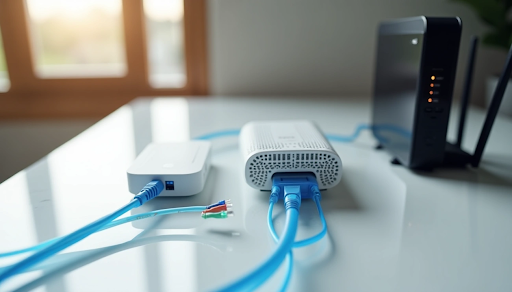Wondering what equipment is needed for fiber optic internet before making the switch? Fiber-optic cables, incredibly thin strands less than a tenth the diameter of a human hair, are revolutionizing how we connect to the internet. Unlike traditional cable services, fiber internet transmits data using pulses of light rather than electrical signals, delivering speeds up to 10Gbps with remarkable reliability.
Many people ask, “Do you need a modem for fiber?” The answer is actually no—fiber optic equipment differs significantly from cable setups. Instead of a traditional modem, fiber internet requires an Optical Network Terminal (ONT) that converts light signals into electrical signals your devices can understand. Additionally, you’ll need a compatible router to distribute your connection throughout your home. The differences between fiber modem vs cable modem setups extend beyond just the hardware—fiber provides synchronous upload and download speeds, essentially eliminating the frustrating lag that cable users often experience during peak hours.
In this comprehensive guide, we’ll break down exactly what you need for both fiber and cable internet setups in 2025, helping you understand which option might better suit your needs.
Essential Equipment for Fiber Internet
Setting up fiber internet requires specific equipment to handle light-based data transmission. Let’s explore what you’ll need for an optimal fiber optic setup.
Fiber Optic Cables: How Data Travels as Light
Fiber optic cables consist of incredibly thin strands of glass or plastic – less than one-tenth the thickness of a human hair. These cables contain a core surrounded by cladding and a protective outer coating. Unlike copper cables, fiber optic cables transmit data via pulses of light. The cladding guides light along the core using total internal reflection, allowing signals to travel farther without weakening.
Because fiber uses light rather than electrical signals, these cables offer superior bandwidth capacity and are less susceptible to electromagnetic interference. Furthermore, fiber connections are notably more difficult to hack than copper or satellite connections, providing enhanced security for your network.
ONT Device: The Fiber Modem Replacement
The Optical Network Terminal (ONT) serves as the interface between your internet service provider and your home network. This device converts optical signals from fiber cables into electrical signals your devices can understand. Unlike traditional internet, fiber doesn’t use a modem – the ONT replaces it entirely.
Typically installed inside your home near where the fiber cable enters the building, the ONT is usually wall-mounted in a utility area or garage. This compact device connects to your router through an Ethernet cable and is an essential component of any fiber optic internet system[42].
Router Compatibility: Do You Need a Special Router for Fiber?
While you don’t need a “fiber-specific” router, you do need one capable of handling fiber’s high speeds. Standard cable routers may bottleneck your connection, preventing you from experiencing the full potential of fiber internet.
For optimal performance, look for routers that support gigabit speeds or higher. Features like dual-band WiFi and strong signal support can significantly improve your experience. Many fiber providers offer compatible routers as part of their installation package, though you can also purchase your own if preferred.
Ethernet Cables: Cat5e vs Cat6 for Maximum Speed
Choosing the right Ethernet cables can maximize your fiber connection’s performance. Cat5e cables support speeds up to 1Gbps over distances up to 100 meters. Meanwhile, Cat6 cables offer enhanced performance with speeds up to 10Gbps for distances up to 55 meters.
The primary differences between them include:
- Cat6 uses thicker 23 AWG copper conductors compared to Cat5e’s 24 AWG
- Cat6 cables have better shielding, including a “spline” separator that reduces crosstalk[62]
- Cat6 operates at frequencies up to 250 MHz versus Cat5e’s 100 MHz
For future-proofing and better PoE (Power over Ethernet) performance, Cat6 is generally worth the slightly higher cost.
WiFi Management Apps: Control Your Network Easily
Modern fiber internet often comes with dedicated WiFi management apps that put network control at your fingertips. These apps allow you to:
- Manage screen time and user access for connected devices[72]
- Track data usage by device
- Create guest networks and share access via QR codes or text[72]
- Run speed tests to verify your connection[72]
- Pause internet access for specific devices or set scheduled downtime
These applications make managing your home network simple and intuitive, eliminating the need to access complicated router settings.
Surge Protectors and UPS: Protecting Your Fiber Setup
Power surges can damage your fiber equipment, particularly the ONT and router. A quality surge protector helps safeguard these devices by blocking sudden voltage spikes.
For enhanced protection, consider an Uninterruptible Power Supply (UPS). A UPS provides both surge protection and battery backup during power outages, keeping your internet running during brief interruptions. This is especially valuable if you work from home or rely heavily on your internet connection[82].
Essential Equipment for Cable Internet
Cable internet relies on a different set of equipment than fiber connections. Understanding these components helps optimize your home network performance.
Coaxial Cables: The Backbone of Cable Internet
Cable internet transmits data through coaxial cables, which feature a copper core surrounded by insulation, a conductive shield, and an outer jacket. This shielded design allows for rapid data transmission while protecting against external interference. For home installations, 75Ω RG-6 coaxial cable is the industry standard, offering better shielding and less signal loss than the older RG-59 type.
Cable Modem: DOCSIS 3.0 vs 3.1 vs 4.0
Your cable modem translates data between your home network and your service provider through DOCSIS technology:
- DOCSIS 3.0 (2006): More affordable ($50-$150) but limited to slower speeds
- DOCSIS 3.1 (2013): Supports speeds up to 10Gbps with enhanced security features, though more expensive ($150-$250+)
- DOCSIS 4.0 (2020): Maintains 10Gbps download capacity but increases upload speeds to 6Gbps
Although DOCSIS 3.0 remains functional for basic internet needs, DOCSIS 3.1 has become the current standard for high-speed connections. DOCSIS 4.0 equipment, despite being officially released, isn’t yet widely available for retail purchase.
Router Setup for Cable: What to Look For
Setting up your router requires connecting an ethernet cable from one of the router’s numbered ports to your computer, then linking your modem to the router’s internet port. Most modern routers automatically configure through DHCP, although some networks require MAC address cloning for proper identification.
Splitters and Amplifiers: When Are They Needed?
Signal splitters divide your incoming connection among multiple devices. Each 2-way split reduces signal strength by approximately 3.5dB on each output leg. For homes with more than 2-3 connected devices, amplifiers may become necessary to boost weakened signals.
For unequal cable runs, directional couplers (taps) offer a better solution than standard splitters by sending more signal to longer cable runs and less to shorter ones. Nevertheless, cable amplifiers should be used cautiously as they amplify both signal and noise.
Fiber Modem vs Cable Modem: Key Differences
The core differences between fiber and cable internet lie in their transmission technologies, affecting everything from speed to connection quality. Let’s examine what sets these systems apart.
Signal Type: Light Pulses vs Electrical Signals
Fiber optic networks transmit data as pulses of light through thin glass or plastic strands, whereas cable internet delivers information via electrical signals through copper coaxial cables. This fundamental difference gives fiber several advantages—light signals travel at approximately 186,000 miles per second and experience minimal degradation over long distances. Moreover, fiber remains unaffected by electromagnetic interference that commonly disrupts cable connections.
Speed and Latency: Synchronous vs Asynchronous
One standout feature of fiber internet is its synchronous speed capability—upload speeds match download speeds. In contrast, cable internet is asymmetric, with upload speeds typically one-tenth or less of download speeds. Latency figures further illustrate this performance gap: fiber averages just 1-5 milliseconds compared to cable’s 10-30 milliseconds. Practically speaking, downloading a 5GB file takes merely 40 seconds on fiber versus approximately 8 minutes on cable.
Installation and Port Types: RJ45 vs Coaxial
Fiber connections rely on optical network terminals (ONTs) that connect to your router via standard RJ45 Ethernet ports. Cable setups use coaxial cable outlets with their distinctive round connector linking to your cable modem. Fiber installation tends to be more complex, often requiring professional technicians and potentially costing between $50-$100. Conversely, cable installations frequently leverage existing infrastructure, making self-installation possible.
Do You Need a Modem for Fiber?
Surprisingly, fiber optic internet doesn’t use a modem at all. Since modems primarily convert electrical signals—which fiber doesn’t use—fiber connections instead rely on an ONT. This specialized device translates light signals into digital data your devices can understand. Yet in everyday function, the ONT serves a similar purpose as a cable modem, acting as the bridge between your ISP and home network.
Optional Accessories to Improve Performance
Beyond the essential components of your internet setup, certain accessories can maximize network performance throughout your home. These optional add-ons address common connectivity challenges that affect both fiber and cable internet users.
Mesh WiFi Systems vs Extenders
When dealing with dead zones in your home, you have two main options for expanding coverage. WiFi extenders are simple devices that rebroadcast your existing signal, creating a secondary network (typically named with “_EXT” added to your network name). Unfortunately, you must manually switch between networks as you move around your house, which can be frustrating.
Mesh WiFi systems, however, use multiple nodes to create one seamless network throughout your entire home. Unlike extenders that can reduce performance by up to 50% due to repeating every packet they receive, mesh systems intelligently route traffic between nodes. Moreover, mesh networks automatically connect your devices to the strongest node without requiring manual switching.
Powerline Adapters for Hard-to-Reach Areas
For spaces where WiFi struggles to reach, powerline adapters offer a clever solution. These devices use your home’s existing electrical wiring to transmit internet signals between rooms. Simply plug one adapter near your router (connected via Ethernet) and another in the distant room where you need connectivity.
Powerline adapters typically deliver more stable connections than WiFi in areas with interference. Yet, they can be affected by older electrical wiring or interference from large appliances. In testing, MoCA adapters (which use coaxial cable lines instead) proved approximately twice as fast at short range and four times faster over distances of 50-60 feet.
Wall Mounts and Stands for Better Router Placement
Router placement significantly impacts your overall connection quality. Mounting your router high on a wall or using a dedicated stand improves signal distribution throughout your home. Ideally, position your router centrally at elevation, away from metal objects, concrete walls, and other electronics that may cause interference.
Comparison Table
| Feature | Fiber Internet | Cable Internet |
| Signal Type | Light pulses | Electrical signals |
| Primary Equipment | ONT (Optical Network Terminal) | Cable Modem (DOCSIS) |
| Modem Required | No | Yes |
| Speed Capability | Up to 10Gbps | Up to 10Gbps (DOCSIS 3.1/4.0) |
| Upload/Download | Synchronous speeds | Asymmetric speeds (upload typically 1/10 of download) |
| Latency | 1-5 milliseconds | 10-30 milliseconds |
| Cable Type | Fiber optic cables (glass/plastic strands) | Coaxial cables (copper core) |
| Cable Thickness | Less than 1/10 human hair | RG-6 75Ω standard |
| Connection Port | RJ45 Ethernet | Coaxial |
| Installation | Professional installation required ($50-$100) | Self-installation possible |
| Signal Interference | Resistant to electromagnetic interference | Susceptible to electromagnetic interference |
| Example Performance | 5GB file download: ~40 seconds | 5GB file download: ~8 minutes |
Conclusion
The comparison between fiber and cable internet equipment reveals significant differences that impact your overall experience. Fiber internet, with its light-based transmission, clearly offers advantages in speed, latency, and reliability compared to traditional cable systems. Though fiber requires specialized equipment like ONTs instead of modems, this technology delivers synchronous speeds and minimal signal degradation that heavy internet users will appreciate.
Meanwhile, cable internet remains widely accessible and generally requires less complex installation. The familiar coaxial cables and DOCSIS modems continue serving millions of households effectively, particularly for those with modest internet needs. Still, cable’s susceptibility to electromagnetic interference and asymmetrical speeds might frustrate users during peak usage times.
When choosing between these options, consider your specific needs first and foremost. Gamers, remote workers, and households with multiple streaming devices will undoubtedly benefit from fiber’s consistent performance. Conversely, casual internet users might find cable internet perfectly adequate without the potential installation complexity of fiber.
Regardless of which system you choose, both setups can benefit from the optional accessories we’ve discussed. Mesh WiFi systems, powerline adapters, and thoughtful router placement can dramatically improve your experience with either connection type. Additionally, understanding the equipment involved helps you make informed decisions when troubleshooting issues or upgrading your setup.
We believe that while fiber represents the future of internet connectivity, cable internet remains a practical choice for many users in 2025. Ultimately, the best choice depends on your specific needs, budget, and the infrastructure available in your area.
FAQs
Q1. What is the main difference between fiber and cable internet?
Fiber internet uses light pulses to transmit data through thin glass or plastic strands, while cable internet uses electrical signals through copper coaxial cables. This fundamental difference gives fiber advantages in speed, reliability, and resistance to electromagnetic interference.
Q2. Do I need a modem for fiber internet?
No, you don’t need a traditional modem for fiber internet. Instead, fiber connections use an Optical Network Terminal (ONT) that converts light signals into digital data your devices can understand. The ONT serves a similar purpose to a cable modem but is specifically designed for fiber optic technology.
Q3. What speeds can I expect from fiber vs. cable internet?
Fiber internet can offer symmetrical speeds up to 10Gbps for both downloads and uploads. Cable internet, using the latest DOCSIS 3.1 or 4.0 technology, can also reach up to 10Gbps for downloads, but upload speeds are typically much slower, often around one-tenth of the download speed.
Q4. Is special equipment required for setting up fiber internet?
Yes, fiber internet requires specific equipment. You’ll need an Optical Network Terminal (ONT) instead of a modem, a router capable of handling high speeds, and potentially new Ethernet cables (Cat5e or Cat6) to maximize performance. Professional installation is often necessary for fiber setups.
Q5. How can I improve my home network performance?
To enhance your home network, consider using a mesh WiFi system for better coverage, powerline adapters for hard-to-reach areas, and optimizing your router placement. Additionally, using surge protectors and UPS devices can protect your equipment and ensure consistent connectivity during power fluctuations.





























